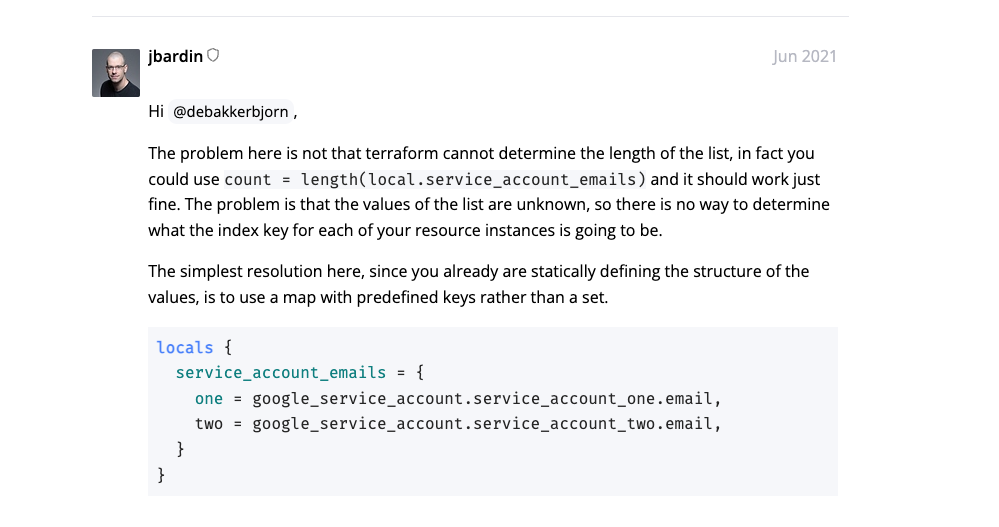通过Terraform创建云主机时,在某些业务场景下,一个机器需要挂载多个云盘,一般云厂商都是单独创建云主机和云硬盘然后通过attachment的资源去挂载,因此我们的模板大致如下:
1 2 3 4 5 6 7 8 9 10 11 12 13 14 15 16 17 18 19 20 21 22 23 24 25 26 27 resource "tencentcloud_instance" "basic" { instance_name = var.instance_name password = "xxx" } resource "tencentcloud_cbs_storage" "storage" { for_each = var.data_disks storage_name = each.key storage_type = each.value.disk_type storage_size = each.value.size } resource "tencentcloud_cbs_storage_attachment" "attachment" { count = length(tencentcloud_cbs_storage.storage) storage_id = element(values(tencentcloud_cbs_storage.storage)[*].id, count.index) instance_id = tencentcloud_instance.basic.id } variable "data_disks" { type = map(object({ disk_type = string size = number })) description = "Instance Data Disks" default = {} }
这个模板我们一直用了很久,完全满足多盘的需求,也具有一定灵活性,但是随着全方位降本的需求,在服务优化等措施下,业务方评估可以考虑减少云盘数量,因为机型的特殊性,机器也不能回收重新创建。
因为之前一直没有减盘的场景,所以一直没关注,直到最近业务方评估需要减盘,发现在减盘时盘的attachment会销毁重新创建,腾讯云这个资源的操作会伴随unmount动作,导致减盘之后盘没有被挂载上
这个现象是不在我的预期当中的,分析Terraform的日志:
1 2 3 4 5 6 7 8 9 10 11 12 13 14 15 16 17 18 19 20 21 22 23 24 25 26 27 # tencentcloud_cbs_storage_attachment.attachment[0] must be replaced -/+ resource "tencentcloud_cbs_storage_attachment" "attachment" { ~ id = "disk-mcklmp5z" -> (known after apply) ~ storage_id = "disk-mcklmp5z" -> "disk-rspjpenh" # forces replacement # (1 unchanged attribute hidden) } # tencentcloud_cbs_storage_attachment.attachment[1] must be replaced -/+ resource "tencentcloud_cbs_storage_attachment" "attachment" { ~ id = "disk-rspjpenh" -> (known after apply) ~ storage_id = "disk-rspjpenh" -> "disk-k9c5lg1v" # forces replacement # (1 unchanged attribute hidden) } # tencentcloud_cbs_storage_attachment.attachment[2] must be replaced -/+ resource "tencentcloud_cbs_storage_attachment" "attachment" { ~ id = "disk-k9c5lg1v" -> (known after apply) ~ storage_id = "disk-k9c5lg1v" -> "disk-jl5g1u7f" # forces replacement # (1 unchanged attribute hidden) } # tencentcloud_cbs_storage_attachment.attachment[3] must be replaced -/+ resource "tencentcloud_cbs_storage_attachment" "attachment" { ~ id = "disk-jl5g1u7f" -> (known after apply) ~ storage_id = "disk-jl5g1u7f" -> "disk-mytvnnif" # forces replacement # (1 unchanged attribute hidden) }
发现attachment的索引是index,减盘的时候索引会重新计算,这就是attachment资源被销毁重建,导致云盘被卸载的原因。
原因明确了,那就好解决了,可以用for_each来解决这个问题,如下:
1 2 3 4 5 resource "tencentcloud_cbs_storage_attachment" "attachment" { for_each = toset(values(tencentcloud_cbs_storage.storage)[*].id) storage_id = each.key instance_id = tencentcloud_instance.foo.id }
事情往往没那么顺利:
1 2 3 4 5 6 7 8 9 10 11 │ Error: Invalid for_each argument │ │ on main.tf line 61, in resource "tencentcloud_cbs_storage_attachment" "attachment": │ 61: for_each = toset(values(tencentcloud_cbs_storage.storage)[*].id) │ ├──────────────── │ │ tencentcloud_cbs_storage.storage is object with 6 attributes │ │ The "for_each" value depends on resource attributes that cannot be │ determined until apply, so Terraform cannot predict how many instances will │ be created. To work around this, use the -target argument to first apply │ only the resources that the for_each depends on.
好吧,在Terraform论坛发现一个issue:https://discuss.hashicorp.com/t/the-for-each-value-depends-on-resource-attributes-that-cannot-be-determined-until-apply/25016
简而言之,就是foreach要求他的map key必须是已知明确的值,不能是依赖其他资源的值,所以会有如上错误。知道限制了调整下模板:
1 2 3 4 5 resource "tencentcloud_cbs_storage_attachment" "attachment" { for_each = var.data_disks storage_id = tencentcloud_cbs_storage.storage[each.key].id instance_id = tencentcloud_instance.basic.id }
圆满解决,新创建的实例用上新的模板,但是存量的实例无法调整还是得忍受下盘重新挂载的问题。

